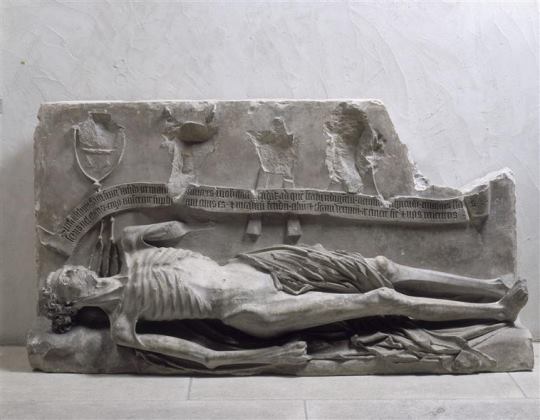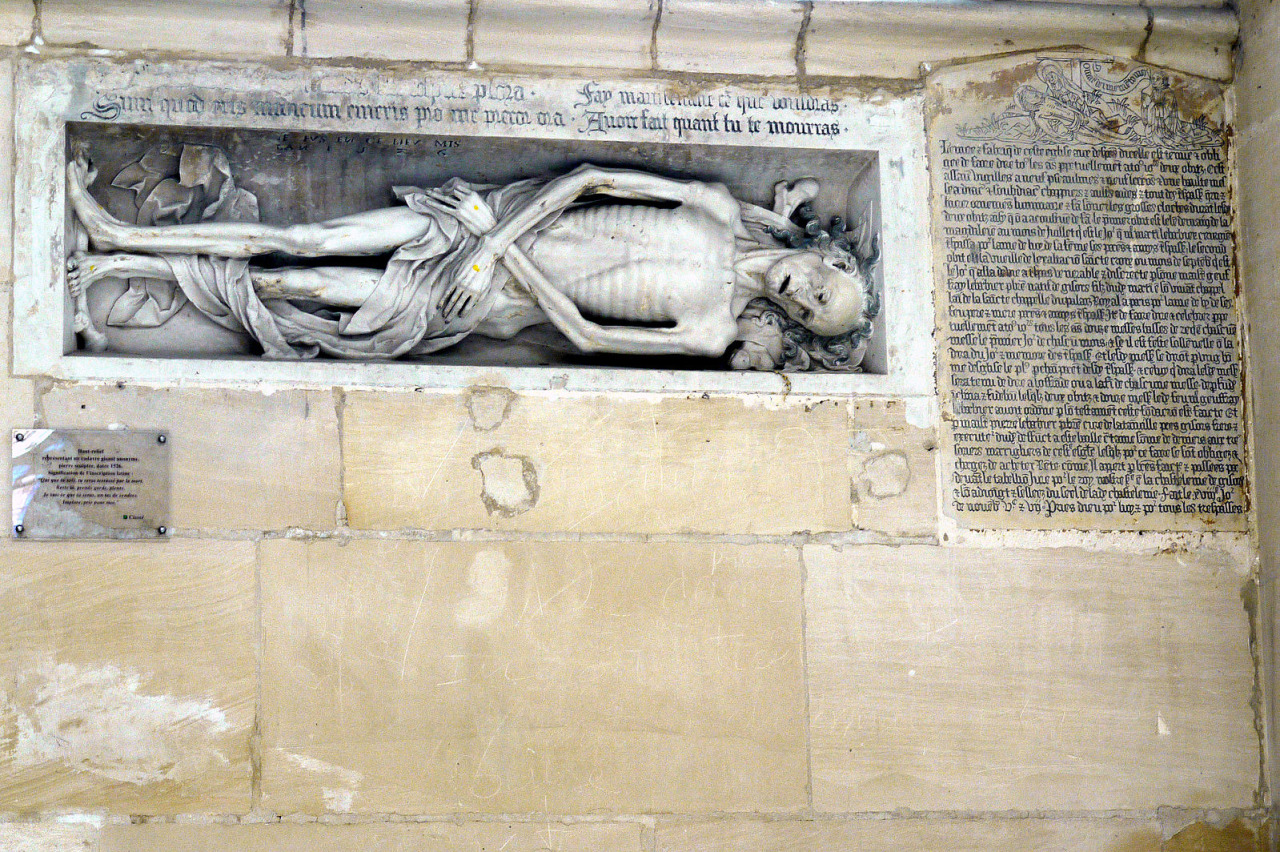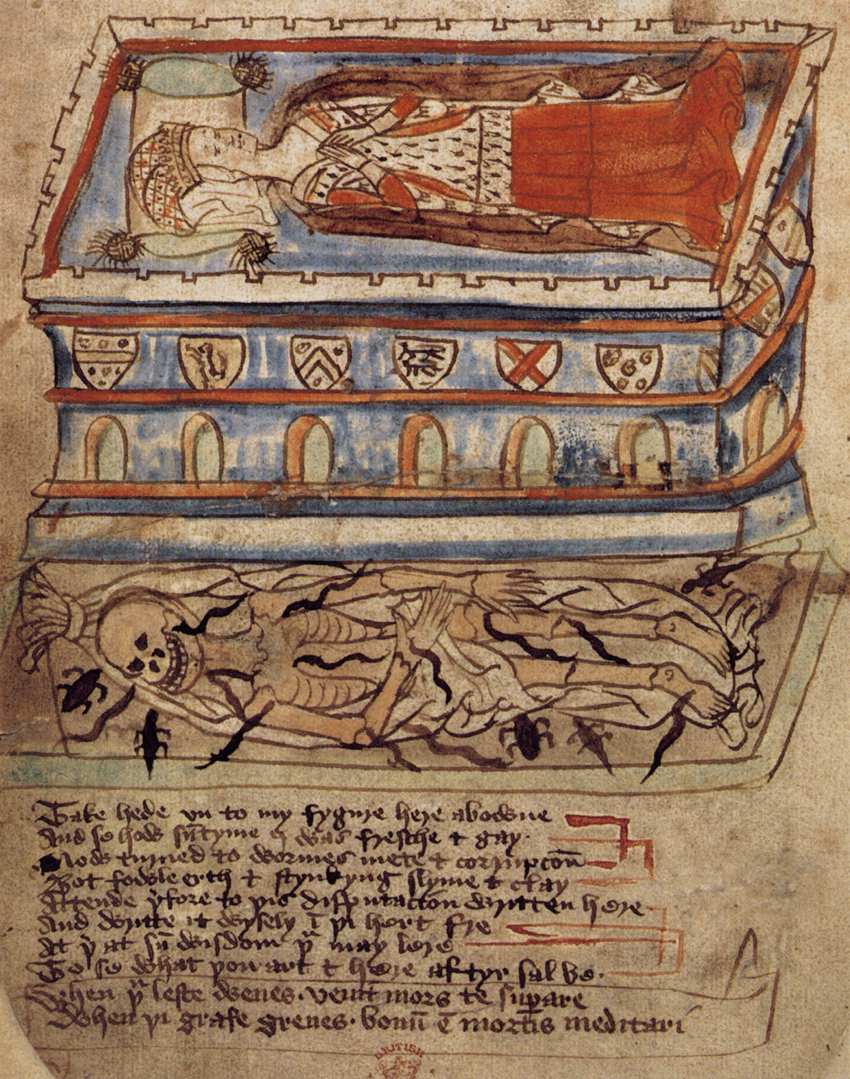Transi Tombs: Living Up Front, Dead Man's Party Out Back
Originally published on The Order of the Good Death blog.
Elizabeth Harper, relic hunter and mistress of All the Saints You Should Know, and Caitlin Doughty, boring ol’ medievalist mortician of The Order of the Good Death, bring you their correspondence on transi tombs. We hope to one day turn it into a cable access chat show. Geek out with us!
Elizabeth
I loved that cadaver tomb you posted on Facebook the other day. (Cadaver tomb always sounds redundant to me but whatevs.) It reminds me of this bad boy who’s been lurking in my “things to write about” folder. Thought you might like him.
Caitlin
I guess “cadaver tomb” is kind of redundant, as tomb implies that a dead body is found within. But I’m going to make the bold declaration that cadaver tombs get a pass on the extra emphasis because they are tombs with actual cadavers on them. Best of both worlds! Did you find this beauty on your travels?
Elizabeth
It’s at St. Gervais et Protais in Gisor, France. It’s set into the wall, lurking in the shadows under a window. Kids have scratched their names right below it as if a little lively mischief could take away the pall the sculpture casts over this corner.
What’s crazy about this particular piece is there is no dead body. When I saw it thought it must be a cadaver tomb (which I learned is also called a transi tomb sometimes- as intransitioning from death to eternal life) but after a little research, I found out it’s not. I guess you would classify it more as a memento mori? It’s so similar to the one you posted though and they’re both French. Do you have any more information on yours?
Caitlin
Today is your lucky day. Mallory, who sent in the tomb (like you and I, Mallory is a fan of deathstinations) had a ton of info. It’s the tomb of Cardinal Jean de la Grange, c.1325 – 1402. This is considered an early example of a transi, or cadaver tomb, because his body is really in there. +1 for body. Body or it didn’t happen.
Our Cardinal de la Grange was a Benedictine monk who lived through the Black Death in France, at a time where 50% of people in his town of Avignon died. This is how the inscription on the tomb translates: “We are a spectacle to the world. Let the great and humble, by our example, see to what state they shall be inexorably reduced, whatever their condition, age or sex. Why then, miserable person, are you puffed with pride? Dust you are, and unto dust you shall return, rotten corpse, morsel and meal for worms.”
I like that he calls us “rotten corpse” at the end there. It’s good strong death acceptance rhetoric. Transi tombs are great, but you know what my favorite are? DOUBLE DECKER TRANSI TOMBS.
Elizabeth
Well now it’s YOUR lucky day! Because Cardinal de la Grange’s tomb USED TO BE A DOUBLE DECKER! I just found that little nugget out while I was searching for more info on my memento mori. According to a conservationist at the Louvre, the tomb used to show the Cardinal in life above the corpse part of the tomb but it was knocked down during the Revolution. The salvageable pieces were split up and the corpse stayed in Avignon. So we’re only seeing half of it. The double decker transi tombs are so awesome—business up top, naked decomposition down below. Truly the mullet of tombs (and I mean that lovingly).
I’ve also got to hand it to the Cardinal’s tomb for having a badass epigraph. My tomb at St. Gervais is a little more tempered. It translates to “Whoever you are, you will be overcome by death. Stay here, take care, and weep. I am what you will be, a heap of ashes. I implore you, pray for me.”
The sculpture is probably from around 1526.The conservationist points out that people weren’t dissecting corpses yet, so the anatomy is always a little impressionistic. Our dead friend in the wall here has too many ribs, for example.
Here’s some of the reading material I dug up on our transi tombs, if you want to peruse. The first link is choice.
Représentation du corpse- le transi by Geneviève Bresc Bauthier (link)
Caitlin
The mullet of tombs! Truer words were never spoken. And yes I will absolutely peruse any and all cadaver tomb information.
I’ll leave you with one of my fave double decker transi tombs, John FitzAlan, 14th Earl of Arundel (much better than the 13th Earl). I use this picture in talks all the time, to silence any naysayers on the point that late medieval tombs were the realest and best of all tombs.
So I am, so you shall be! Look upon me, one in the bloom of life, now a rotten corpse, ravaged by death. I just made that one up, but it’s pretty to form. We could use more of these now, instead of flat grave markers that try to hide that people are buried and make cemeteries look like parks. I’ll take my corpses and the reality of death, please.
Can I post this to the Order? I feel like people will love a good transi tomb. How can they help but capture a deathling’s black heart?
Elizabeth
Yes, definitely post this to the blog!
I’m having so much fun over here learning about transi tombs. No really. The More You Know rainbow-star is shooting out of my house right now. And I’m right there with you. Let’s bring back the transi tomb. They’re beautiful, they’re unflinching, they’re personal and still universal. What more could you ask for in a memorial? Maybe transi tombs were like Medieval art therapy– a way to come to grips with the fact that you’ll become ashes and dirt without believing you are ashes and dirt.
(P.S. After reading more about these two fascinating examples I found out that the guy who was buried beneath Caitlin’s tomb, Cardinal Lagrange, was quite a character. He picked a fight with the pope after he ignored a Papal Bull against dismembering corpses. Who’s corpse did he dismember, you ask? HIS OWN. He specified in his will that he wanted his bones boiled and buried in Amiens and a separate flesh burial in Avignon. --EH)
(First photo: Tomb of Cardinal Jean de la Grange, c.1325 – 1402, Second photo: Tomb at St. Gervais et Protais in Gisor, France, Illustration: Transi Tomb, c. 1435-40)



